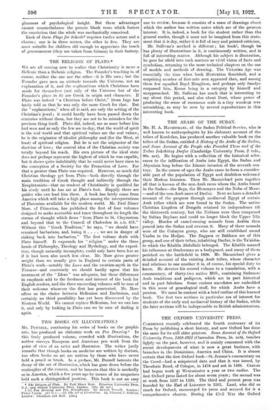THE ARABS OF . THE SUDAN.
MR. H. A. MeCNKSAEL, of the Sudan Political Service, who is well known to anthropologists by his elaborate account of the tribes of Kordofan, has produced another valuable book on the tribes of the Sudan, entitled A History of the Arabs of the Sudan, and Some Account of the People who Preceded Them and of the Tribes Inhabiting Darfur (Cambridge University Press, 2 vols., 90s. net). He begins with a collection of the historical refer- ences to the infiltration of Arabs into Egypt, the Sudan and .Abyssinia long before the Islamic invasion of the seventh core tury. In the course of ages the Arabs came to form a consider- able part of the population of Egypt and doubtless welcomed their Moslem kinsmen. Then Mr. Macmichael puts together all that is known of the non-Arab races whom the Arabs found in the Sudan—the Bega, the Blemmyes and the Nuba of Meroe —and of the non-Arab races of Darfur. Next we have a detailed account of the progress through mediaeval Egypt of certain Arab tribes which are now found in the Sudan. The native Christian kingdom of Dongola retained its independence till the thirteenth century, but the Nubians were then conquered by Sultan Baybars and could no longer block the Upper Nilo valley. Hordes of camel-owning nomads from Arabia then poured into the Sudan and overran it. Many of these nomads were of the Guhayna group, who are still established round Yanbu in the Hedjaz. The Baggara or Bakker& are of this group, and one of their tribes, inhabiting Darfur, is the Ta'aisha, to which the Khalifs. Abdullahi belonged. The Khalif a massed his tribesmen at Omdurman as a bodyguard, and many of them perished on the battlefield in 1898. Mr. Macmichael gives a detailed account of the existing Arab tribes, whose character and relations to one another it is, of course, his special duty to know. He devotes his second volume to a translation, with a commentary, of thirty-two native MSS., containing Sudanese Arab traditions and pedigrees, which are in part historical and in part fabulous. Some curious anecdotes are embedded in this mass of genealogical stuff, for which Arabs have a passion. We must be content with a brief outline of this learned book. The first two sections in particular are of interest for students of the early and mediaeval history of the Sudan, while the later sections will be indispensable to British administrators.


































 Previous page
Previous page